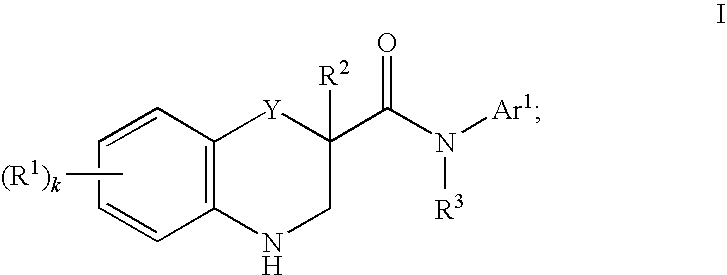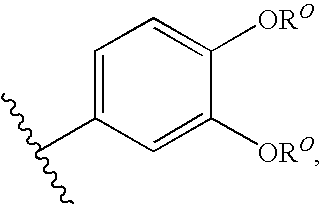Modulators of cystic fibrosis transmembrane conductance regulator
- Summary
- Abstract
- Description
- Claims
- Application Information
AI Technical Summary
Benefits of technology
Problems solved by technology
Method used
Image
Examples
example 1
Preparation of N-(4-cyclopentyl-5-hydroxy-2-(3-(methylamino)prop-1-ynyl)phenyl)-6-(trifluoromethoxy)-3,4-dihydro-2H-benzo[b][1,4]oxazine-2-carboxamide (Compound 98, Table 1)
[0613]
[0614]6-(Trifluoromethoxy)-3,4-dihydro-2H-1,4-benzoxazine-2-carboxylic acid (490 mg, 1.86 mmol) and (5-amino-4-bromo-2-cyclopentyl-phenyl)methyl carbonate (585 mg, 1.86 mmol) were dissolved in 2-methyltetrahydrofuran (13 mL). Pyridine (376 μL, 4.65 mmol) and T3P (2960 mg, 2.8 mL of 50% w / w solution, 4.66 mmol) were added and the reaction was stirred for 1 h at room temperature. Purification by silica gel chromatography (10-75% ethyl acetate / hexanes) yielded 4-bromo-2-cyclopentyl-5-(6-(trifluoromethoxy)-3,4-dihydro-2H-benzo[b][1,4]oxazine-2-carboxamido)phenyl methyl carbonate (802 mg, 77% yield). LC / MS m / z 560.2 [M+H]+.
[0615]4-Bromo-2-cyclopentyl-5-(6-(trifluoromethoxy)-3,4-dihydro-2H-benzo[b][1,4]oxazine-2-carboxamido)phenyl methyl carbonate (812 mg, 1.45 mmol), triethylamine (2.0 mL, 14.52 mmol), prop-2-yn...
example 2
Preparation of N-(4-methyl-2-(3-morpholinoprop-1-ynyl)phenyl)-6-(trifluoromethoxy)-3,4-dihydro-2H-benzo[b][1,4]oxazine-2-carboxamide (Compound 100, Table 1)
[0617]
[0618]6-(Trifluoromethoxy)-3,4-dihydro-2H-1,4-benzoxazine-2-carboxylic acid (600 mg, 2.28 mmol) and 2-bromo-4-methyl-aniline (424 mg, 286 μL, 2.28 mmol) were dissolved in 2-methyltetrahydrofuran (7 mL) and pyridine (461 μL, 5.70 mmol). T3P (2902 mg, 2.7 mL of 50% w / w solution, 4.56 mmol) was added and the reaction was stirred for 30 min at room temperature. Purification by silica gel chromatography (10-100% ethyl acetate / hexanes) provided N-(2-bromo-4-methylphenyl)-6-(trifluoromethoxy)-3,4-dihydro-2H-benzo[b][1,4]oxazine-2-carboxamide (743 mg, 76% yield). LC / MS m / z 432.4 [M+H]+.
[0619]Prop-2-yn-1-ol (195 mg, 202 μL, 3.48 mmol), N-(2-bromo-4-methyl-phenyl)-6-(trifluoromethoxy)-3,4-dihydro-2H-1,4-benzoxazine-2-carboxamide (300 mg, 0.69 mmol), PdCl2(PPh3)2 (122 mg, 0.17 mmol), CuI (19.88 mg, 0.10 mmol), and triethylamine (970 μ...
example 3
Preparation of N-(4-cyclopentyl-5-hydroxy-2-((4-methylpiperazin-1-yl)methyl)phenyl)-3,4-dihydro-2H-benzo[b][1,4]oxazine-2-carboxamide (Compound 52, Table 1)
[0622]
[0623]To (4-methylpiperazin-1-yl)methyl-(trifluoro)borane (10 mg, 0.053 mmol), Pd(OAc)2, (0.3 mg, 0.0016 mmol), X-Phos (1.5 mg, 0.003 mmol), and Cs2CO3 (51 mg, 0.15 mmol) was added dropwise 4-bromo-2-cyclopentyl-5-(3,4-dihydro-2H-benzo[b][1,4]oxazine-2-carboxamido)phenyl methyl carbonate (25 mg, 0.053 mmol) in THF / water (10:1, 600 μL) under N2 atmosphere. The reaction was heated under microwave irradiation at 100° C. for 45 min. The reaction was cooled to room temperature and treated with 1M NaOH. After 10 min the mixture was filtered and purified by HPLC (10-99% CH3CN / 0.05% TFA) to provide N-(4-cyclopentyl-5-hydroxy-2-((4-methylpiperazin-1-yl)methyl)phenyl)-3,4-dihydro-2H-benzo[b][1,4]oxazine-2-carboxamide trifluoroacetate (1.6 mg, 14% yield). LC / MS m / z 451.5 [M+H]+.
PUM
| Property | Measurement | Unit |
|---|---|---|
| Mass | aaaaa | aaaaa |
| Mass | aaaaa | aaaaa |
| Mass | aaaaa | aaaaa |
Abstract
Description
Claims
Application Information
 Login to View More
Login to View More - R&D
- Intellectual Property
- Life Sciences
- Materials
- Tech Scout
- Unparalleled Data Quality
- Higher Quality Content
- 60% Fewer Hallucinations
Browse by: Latest US Patents, China's latest patents, Technical Efficacy Thesaurus, Application Domain, Technology Topic, Popular Technical Reports.
© 2025 PatSnap. All rights reserved.Legal|Privacy policy|Modern Slavery Act Transparency Statement|Sitemap|About US| Contact US: help@patsnap.com



